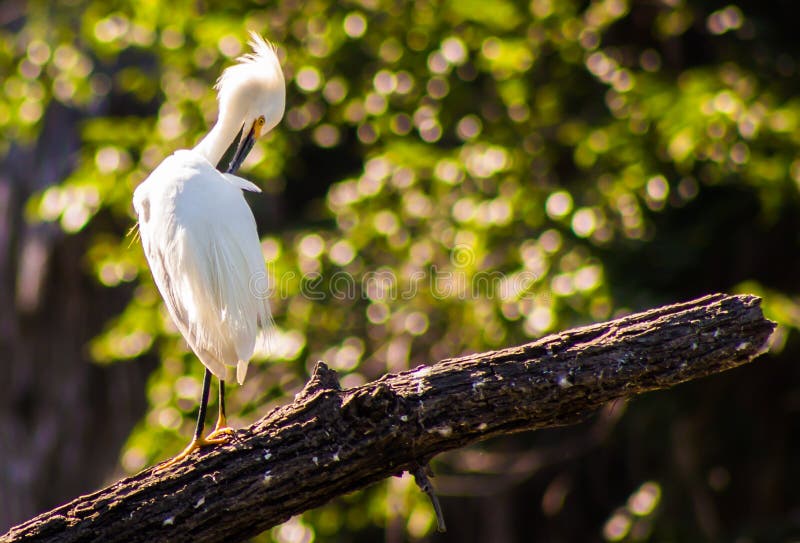The Snowy Egret (Egretta thula) is a small white heron. It is the American counterpart to the very similar Old World Little Egret, which has established a foothold in the Bahamas. Adults are typically 61 cm (24 in) long and weigh 375 g (0.83 lb) They have a slim black bill and long black legs with yellow feet. The area of the upper bill, in front of the eyes, is yellow but turns red during the breeding season, when the adults also gain re-curved plumes on the back, making for a shaggy effect. The juvenile looks similar to the adult, but the base of the bill is paler, and a green or yellow line runs down the back of the legs. Their breeding habitat is large inland and coastal wetlands from the lower Great Lakes and southwestern United States to South America. The breeding range in eastern North America extends along the Atlantic and Gulf Coasts from Maine to Texas, and inland along major rivers and lakes. They nest in colonies, often with other waders, usually on platforms of sticks in trees or shrubs. Their flat, shallow nests are made of sticks and lined with fine twigs and rushes. Three to four greenish-blue, oval eggs are incubated by both adults. The young leave the nest in 20 to 25 days and hop about on branches near the nest before finally departing. In warmer locations, some Snowy Egret are permanent residents; northern populations migrate to Central America and the West Indies. They may wander north after the breeding season, very rarely venturing to western Europeââ¬âthe first bird sighted in Britain wintered in Scotland from 2001ââ¬â2002. The birds eat fish, crustaceans, insects and small reptiles. They stalk prey in shallow water, often running or shuffling their feet, flushing prey into view, as well dip-fishing by flying with their feet just over the water. Snowy Egrets may also stand still and wait to ambush prey, or hunt for insects stirred up by domestic animals in open fields. At one time, the beautiful plumes of the Snowy Egret were in great demand by market hunters as decorations for women's hats. This reduced the population of the species to dangerously low levels.[citation needed] Now protected in the USA by law, under the Migratory Bird Treaty Act, this bird's population has rebounded.
圖片編號:
38116333
拍攝者:
Chadkanera
點數下載
| 授權類型 | 尺寸 | 像素 | 格式 | 點數 | |
|---|---|---|---|---|---|
| 標準授權 | XS | 480 x 326 | JPG | 13 | |
| 標準授權 | S | 800 x 543 | JPG | 15 | |
| 標準授權 | M | 2102 x 1427 | JPG | 18 | |
| 標準授權 | L | 3244 x 2202 | JPG | 20 | |
| 標準授權 | XL | 3433 x 2330 | JPG | 22 | |
| 標準授權 | MAX | 4204 x 2854 | JPG | 23 | |
| 標準授權 | ADD | Vector | AI | 38 | |
| 標準授權 | TIFF | 4588 x 3114 | TIF | 39 | |
| 進階授權 | WEL | 4204 x 2854 | JPG | 88 | |
| 進階授權 | PEL | 4204 x 2854 | JPG | 88 | |
| 進階授權 | UEL | 4204 x 2854 | JPG | 88 |
XS
S
M
L
XL
MAX
ADD
TIFF
WEL
PEL
UEL
| 標準授權 | 480 x 326 px | JPG | 13 點 |
| 標準授權 | 800 x 543 px | JPG | 15 點 |
| 標準授權 | 2102 x 1427 px | JPG | 18 點 |
| 標準授權 | 3244 x 2202 px | JPG | 20 點 |
| 標準授權 | 3433 x 2330 px | JPG | 22 點 |
| 標準授權 | 4204 x 2854 px | JPG | 23 點 |
| 標準授權 | Vector px | AI | 38 點 |
| 標準授權 | 4588 x 3114 px | TIF | 39 點 |
| 進階授權 | 4204 x 2854 px | JPG | 88 點 |
| 進階授權 | 4204 x 2854 px | JPG | 88 點 |
| 進階授權 | 4204 x 2854 px | JPG | 88 點 |


























 +886-2-8978-1616
+886-2-8978-1616 +886-2-2078-5115
+886-2-2078-5115






